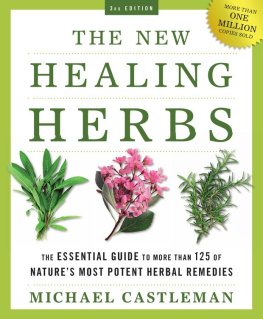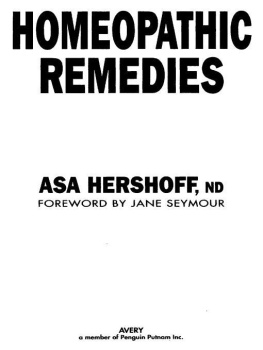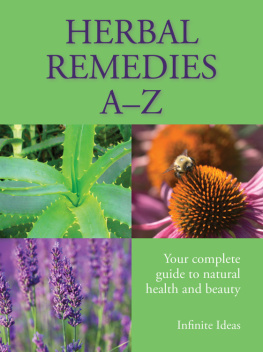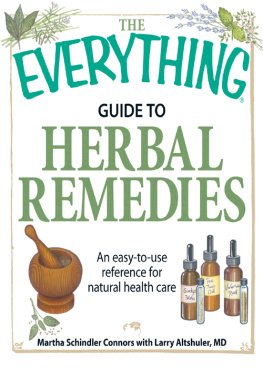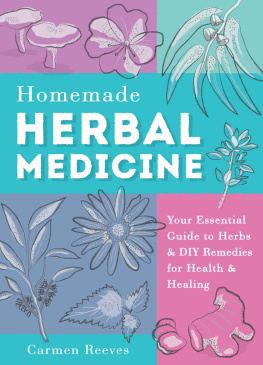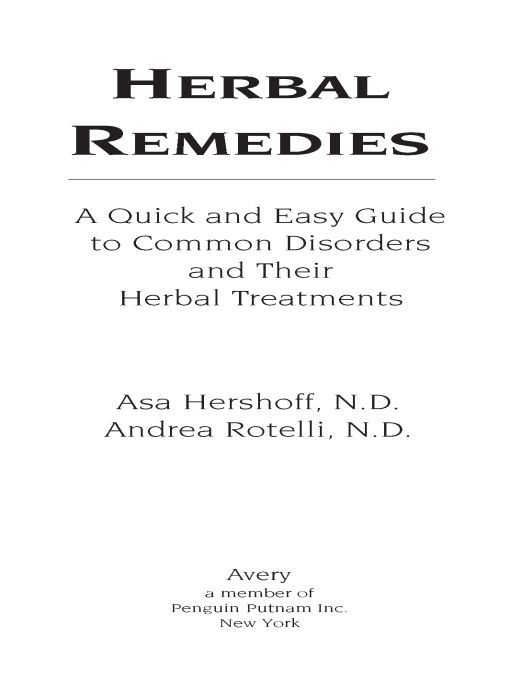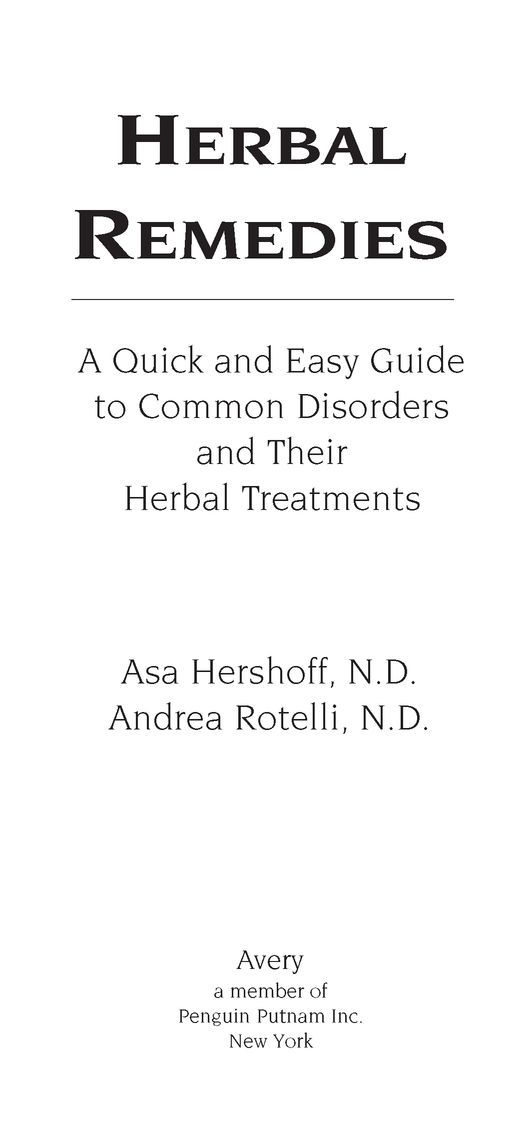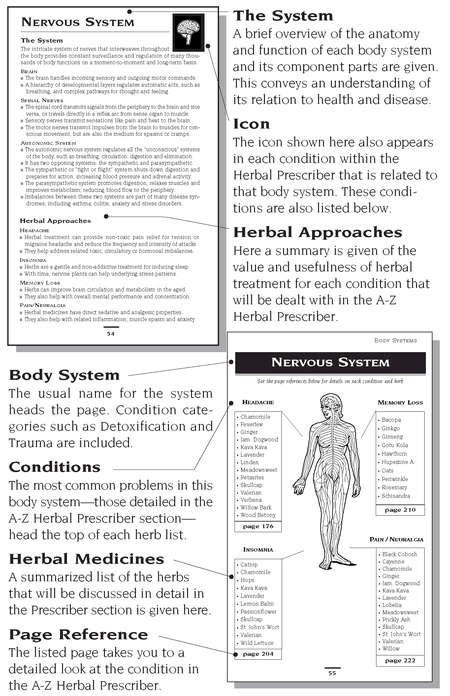Table of Contents
To Our Mothers
Carol and Henrietta
PREFACE
Herbal medicine has gone from fringe to mainstream. It has changed from the exclusive realm of zealous health seekers in natural food stores to mainstream consumers in supermarkets and drugstores everywhere. Everyone is jumping on the herb bandwagon. Yet though there are many herbal texts on the market, this book is a pioneering effort. It is the answer to a problem arising in my own clinical practice of 26 years, and while lecturing and teaching natural medicine around the world to both doctors and the general public alike. I simply have been unable to find or to recommend a quick and easy guide to the effective use of herbs for a variety of conditions.
Most herb books require an intense study of each plant, and information about the treatment of a specific condition is scanty at best. With no models to follow, this book took thousands of hours of painstaking work on the part of Dr. Rotelli and myself to put together all the pieces of information scattered in hundreds of books, articles and research. What we created, I believe, is the most accurate, useful and user-friendly herb book available. The information here is as current and accurate as possible, yet avoids unnecessary jargon or pharmacological terminology, making it suitable for both professionals and lay people.
I designed and laid out the book similarly to my previous work, Homeopathic Remedies (Avery 1999), as it provided an extremely easy-to-use and accessible format. Almost a hundred of my own line drawings are included, so that the whole book is visually appealing and readable. Each condition has a two-page formatsince I personally dislike having to turn pages to find information!
Today, in discussing herbs, one can err on two sides. Some authors ignore thousands of years of clinical herbal experience, feeling that even one poorly designed piece of modern research is superior to traditional knowledge. The German Commission E, so highly touted in herbal circles, falls into this category. On the other hand, exaggerated claims or unfounded statements are equally misleading about the strengths and limitations of herbal medicine. We hope that this book takes a middle path. It comes from practicing naturopathic physicians, not researchers, writers or herbal spokespeople. Our own tradition stretches back to the very roots of the ancient healing arts, and it is our commitment to follow this path with integrity and diligence. We love and respect plants deeply and feel fortunate to be able to apply this knowledge to help others in a world that is so badly in need of healing.
Asa Hershoff & Andrea Rotelli
New York
USING THIS BOOK
Part 1. How to Use Herbs
The first part of this book contains basic information about herbal medicines necessary for prescribing for oneself or for treating others.
Herbal principles provide a framework for understanding and using herbs. These ideas are not mere theory, but objective principles and accurate perceptions of how biological healing works, i.e., how the body heals itself and how herbs enable this process.
These ideas and observations are based on the experience of millions of healing practitioners and their patients across time and space.
While they are a reliable guide to the intelligent use of herbs, these concepts are not complex, esoteric or obscure. Quite the contrary, they are simple and almost self-evident, as any truth should be.
Part 2. Body Systems
The body has separate and distinct systems of organs and tissues. Though powerfully interrelated, each system performs unique and highly specialized functions in the organism, and each has its own needs.
The traditional studies of anatomy, physiology, disease and treatment have all been done according to body systems, such as the digestive, respiratory, nervous and immune systems.
The Body Systems section, beginning on page 51, follows this same classification, but also includes a number of condition categories such as Infections, Trauma, and Detoxification.
This section can serve as a visual summary and rapid reference for locating a health problem and its herbal solution.
For each system, there is a general discussion, followed by a description of the conditions detailed in this book in Part 3.
A diagram of the system (or condition category) is included, showing the specific illnesses discussed in this book and their corresponding herbs. A page number is shown under each of these conditions, leading you to a full discussion of the illness in the A-Z Herbal Prescriber.
There is a further advantage to Body Systems. An individual often does not fit neatly into any one single disease category, and because of this, a large percentage of chronic conditions are never properly diagnosed. Looking at body systems helps get around this problem. Any named condition or disease should be interpreted in the broadest possible sense. For example, the herbs listed under Memory Loss apply to problems as simple as poor performance in school or business to Alzheimers disease.
BODY SYSTEMS
Part 3. A-Z Herbal Prescriber
Apart from looking in the Body Systems section, the easiest way to find the condition or illness that concerns you is through the main section of the book, the A-Z Herbal Prescriber. This alphabetical list of conditions allows one to quickly see what herbal medicines can do for a variety of common problems like fibromyalgia, headache, ADD and so on.
The condition pages in the Prescriber list the ten to fifteen most important herbs used for each problem, disease or symptom complex.
Herbs are listed by their commonly used name, followed by their Latin name. Sometimes an additional common name is listed as well.
The effects of each herb for that condition are described, making for easy selection. More information about that herb for other conditions can be found by checking the herbs listing in the index.
The Herbal Reading List also contains recommended books (with three asterisks***) for learning more about individual herbs.
Cross-references are provided at the end of each condition page so that one can look up a closely related or contributing problem.
An icon in the margin of each page indicates the body system involved, which helps in both finding the right condition and cross-referencing it to similar problems.
Part 4. Herbal Sources, Dosage & Safety
To avoid repetition, dosage and safety information is not given for each herb in the A-Z Herbal Prescriber. Instead, this data is grouped in a separate section, where the herbs are listed alphabetically. Each herb has the following headings:
Sources: A brief description of the herb is given, which may include the part of the plant used, the plant family, its history and effects.
Standardization: For those herbs that have been standardized, the amounts and names of standardized ingredients are shown.
Dosage: The recommended dosage for capsules, tinctures or other commonly available forms are provided. Note that this information varies widely and thus following directions on the bottle is useful.


